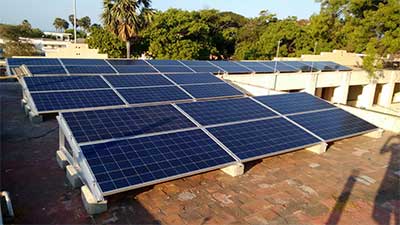GS-3: Infrastructure: Energy
Key phrases - MNRE, rooftop solar
Why in news-
Re-vamped MNRE scheme improves growth prospects for rooftop solar market
Analysis:
What is rooftop solar?
- To generate solar power by installing solar panels on the roof of the houses, Ministry of New and Renewable Energy, Government of India is implementing Grid-connected Rooftop Solar Scheme
- National Solar Mission has set a target of 1,00,000 MW power generation through solar energy in the country. This includes 40,000 MW to be contributed through solar rooftops in various sectors
- Under this scheme Ministry is providing 40% subsidy for the first 3 kW and 20% subsidy beyond 3 kW. Residential consumers willing to set-up a rooftop solar plant under MNRE scheme can apply online and get rooftop solar plants installed by listed vendors
Importance of this scheme
- More efficient: There is no transmission loss in utilization of electricity generated through the SRT system. Further, maintenance cost of SRT System is also less
- Mitigate the dependence on fossil fuel based electricity generation and encourage environment-friendly Solar electricity generation
- Increase in penetration of rooftop solar in the distribution grid will have a significant impact on the stability of the grid
- Create an enabling environment for investment in the solar energy sector by the private sector, state government and the individuals
- Installation of rooftop solar will bring down the electricity consumption of the households and save electricity expenditure
- Programme has directed employment potential. Besides increasing self-employment the approval is likely to generate employment opportunity equivalent to 9.39 lakh job years for skilled and unskilled workers
- Great benefit of being able to provide electricity to those areas that are not yet connected to the grid — remote locations and areas where the terrain makes it difficult to set up power stations and lay power lines
Potential and status
- Ministry of New and Renewable Energy has pegged the market potential for rooftop solar at 124 GW
- National Solar Mission has set a target to achieve 100 GW of installed capacity of solar energy by the end of 2022. Out of this, 40 GW is the target set for the SRT System
- Addressable market for residential rooftop solar systems is about 52 million households by 2030 (10 per cent of urban independent households
- India has achieved only 20% of the set target of 40GW by 2022.Covid-19 has also taken a toll on the adoption of the SRT system
- Only about 0.4 per cent of independent urban homes, equivalent to 0.4 million are estimated to have installed rooftop solar systems so far
Why is rooftop solar adoption lacking?
- Consumer inhibition and low awareness about technical, financial and operational aspects of installations
- Rooftop solar is not deemed as an essential purchase because of improving reliability of grid power.
- Significant proportion of urban affluent population does not also have access to rooftop rights or is unwilling to make a long term cost commitment
- Households attach a very high financial (ability to expand the building vertically) and/ or social value (space for leisure or games, utility needs) to rooftop, where available, restricting growth prospects
- Cost increases arising from rise in module cost, import duties and GST are also a potential dampener in the short-term
Efforts by government
- Revamped MNRE scheme for rooftop installation improves growth prospects for rooftop solar market
- Entry of larger players such as Tata Power, Mahindra and Reliance, is further expected to catalyse market growth
- Free net metering in most states also strengthens the investment case for residential rooftop solar
- The Reserve Bank of India has included a loan limit of .₹10 lakh per household for installation of renewable energy equipment including solar PV systems under priority sector lending
Way ahead
- Indian policymakers need to plan for rooftop solar plus storage, rather than rooftop solar alone with the grid as storage (net / gross metering)
- Creation of a conducive battery manufacturing ecosystem on a fast track could cement India’s opportunity for radical economic and industrial transformation
- Supportive policies and innovative technological approaches are needed for the sector to achieve its potential.
Source: The Hindu BL
Mains question
Q. With slow penetration of rooftop solar system, India’s ambitious target of 175 GW solar by 2022 looks unlikely. How could India increase its share of rooftop solar system? (10 Marks, 150 Words).







